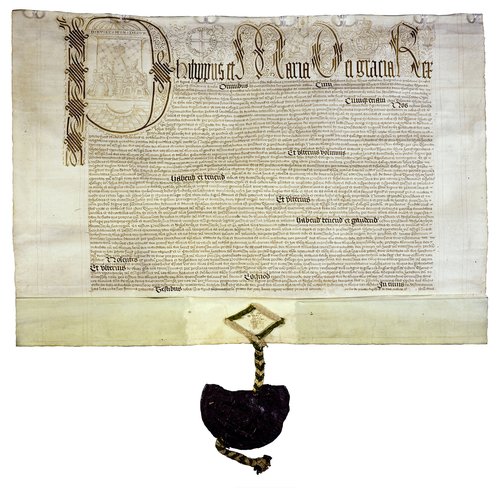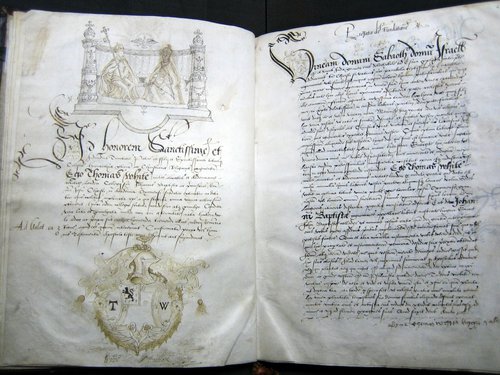On this day – 464 years ago
 May was an important month in the foundation of St. John’s.
There is plenty of evidence that Sir Thomas White had been planning the
founding of the College for several years, but it was in May 1555 that the
College first took form. On the first day
of May, White secured from Queen Mary and King Philip (it is often forgotten
that Philip II of Spain who launched the Armada against Elizabeth I had also briefly
been King Philip of England when married to Elizabeth’s half-sister Mary)
permission to found a college. This was done in the form of a charter known as
Letters Patent (so called because they were issued open rather than closed), which by the mid-sixteenth century had developed into a large parchment
document, illustrated with a picture of the monarch enthroned in the initial
letter, with the Great Seal of England attached to its base.
May was an important month in the foundation of St. John’s.
There is plenty of evidence that Sir Thomas White had been planning the
founding of the College for several years, but it was in May 1555 that the
College first took form. On the first day
of May, White secured from Queen Mary and King Philip (it is often forgotten
that Philip II of Spain who launched the Armada against Elizabeth I had also briefly
been King Philip of England when married to Elizabeth’s half-sister Mary)
permission to found a college. This was done in the form of a charter known as
Letters Patent (so called because they were issued open rather than closed), which by the mid-sixteenth century had developed into a large parchment
document, illustrated with a picture of the monarch enthroned in the initial
letter, with the Great Seal of England attached to its base.
 By this time White had already chosen a site for St. John’s,
having apparently seen the site in a dream before coming to Oxford and
identifying it. This was the site of what had been St. Bernard’s College, a
college for Cistercian monks. Like all other monastic institutions in England
St. Bernard’s had been dissolved by Henry VIII about fifteen years earlier and then later he had given it to Christ Church
when he had refounded Cardinal Wolsey’s college in 1546. By a deed dated 25 May, the Dean and Chapter of Christ Church sold White the site of what the deed
calls Bernerde Colledge in return for a rent of 20 shillings a year and a promise that
if St. John’s could not find one of their own fellows suitable to be President
then it would be a student of Christ Church (this has happened just once and,
of course, no longer applies!).
By this time White had already chosen a site for St. John’s,
having apparently seen the site in a dream before coming to Oxford and
identifying it. This was the site of what had been St. Bernard’s College, a
college for Cistercian monks. Like all other monastic institutions in England
St. Bernard’s had been dissolved by Henry VIII about fifteen years earlier and then later he had given it to Christ Church
when he had refounded Cardinal Wolsey’s college in 1546. By a deed dated 25 May, the Dean and Chapter of Christ Church sold White the site of what the deed
calls Bernerde Colledge in return for a rent of 20 shillings a year and a promise that
if St. John’s could not find one of their own fellows suitable to be President
then it would be a student of Christ Church (this has happened just once and,
of course, no longer applies!).
 Just four days later Sir Thomas issued a charter of his own,
which has become known as the First Foundation Deed. It was made on 29 May 1555
and was both signed by White and had his own personal seal appended to it. It
formally created the College, in a strictly legal sense, by conveying all the
properties that the founder had acquired as the College’s endowment (mostly in
south Oxfordshire and north Berkshire to the west of Abingdon) to five men: the
first President, Alexander Belsyre, and four other scholars, of whom two would
be amongst the first fellows of the College. In fact, it was to be another two
years before the College actually opened as a functioning institution on 24
June (the festival of St. John the Baptist) 1557, but this deed created the
College as a legal corporation and was no doubt done in order to protect the
nascent College’s endowment in case the founder should die before the
foundation of the College was complete.
Just four days later Sir Thomas issued a charter of his own,
which has become known as the First Foundation Deed. It was made on 29 May 1555
and was both signed by White and had his own personal seal appended to it. It
formally created the College, in a strictly legal sense, by conveying all the
properties that the founder had acquired as the College’s endowment (mostly in
south Oxfordshire and north Berkshire to the west of Abingdon) to five men: the
first President, Alexander Belsyre, and four other scholars, of whom two would
be amongst the first fellows of the College. In fact, it was to be another two
years before the College actually opened as a functioning institution on 24
June (the festival of St. John the Baptist) 1557, but this deed created the
College as a legal corporation and was no doubt done in order to protect the
nascent College’s endowment in case the founder should die before the
foundation of the College was complete.
 In fact, Sir Thomas White survived not only to see the
College actually open its doors in 1557, but for another ten years, which was
enough time to see through one last act in the foundation of St. John’s, again
in May, though in 1562. The previous year, White had been one of the key movers
in the foundation of another major educational institution, the Merchant
Taylors’ School in London. So, on 14 May 1562 he officially rewrote
the statutes of St. John’s, now incorporating the rule that at least 37 of the
50 fellowships were to be reserved for alumni of the School. An official copy
was made by John Bereblock, a fellow of the College, with a beautiful drawing
on the title page which has been variously interpreted as the Holy Trinity, as
Philip and Mary, or as Elizabeth and John the Baptist. It is probably intended
to be ambiguous in what by 1562 was a largely crypto-Catholic college in the
emerging Elizabethan Protestant Church. Sir Thomas White signed every page of
Bereblock’s copy.
In fact, Sir Thomas White survived not only to see the
College actually open its doors in 1557, but for another ten years, which was
enough time to see through one last act in the foundation of St. John’s, again
in May, though in 1562. The previous year, White had been one of the key movers
in the foundation of another major educational institution, the Merchant
Taylors’ School in London. So, on 14 May 1562 he officially rewrote
the statutes of St. John’s, now incorporating the rule that at least 37 of the
50 fellowships were to be reserved for alumni of the School. An official copy
was made by John Bereblock, a fellow of the College, with a beautiful drawing
on the title page which has been variously interpreted as the Holy Trinity, as
Philip and Mary, or as Elizabeth and John the Baptist. It is probably intended
to be ambiguous in what by 1562 was a largely crypto-Catholic college in the
emerging Elizabethan Protestant Church. Sir Thomas White signed every page of
Bereblock’s copy.
These statutes were destined to last almost three hundred years, until arguably a new foundation of the College took place when a royal commission insisted on rewriting the statutes of all the colleges of Oxford and Cambridge. St. John’s, a deeply conservative college at that time, resisted and had new statutes forced upon it in 1861, just a year short of three centuries after Sir Thomas White had signed his statutes into law. To be strictly accurate, it was a little under a year and a month short of three hundred years, as the Victorian statutes passed into law in April, not May.